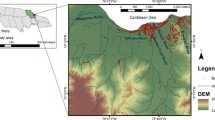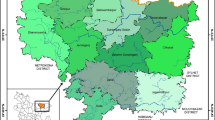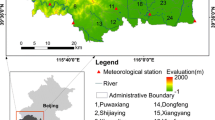Abstract
This paper explores the methodology for compiling the torrent hazard and risk zonation map by means of GIS technique for the Red River Basin in Yunnan province of China, where is prone to torrent. Based on a 1:250,000 scale digital map, six factors including slope angle, rainstorm days, buffer of river channels, maximum runoff discharge of standard area, debris flow distribution density and flood disaster history were analyzed and superimposed to create the torrent risk evaluation map. Population density, farmland percentage, house property, and GDP as indexes accounting for torrent hazards were analyzed in terms of vulnerability mapping. Torrent risk zonation by means of GIS was overlaid on the two data layers of hazard and vulnerability. Then each grid unit with a resolution of 500 m × 500 m was divided into four categories of the risk: extremely high, high, moderate and low. Finally the same level risk was combined into a confirmed zone, which represents torrent risk of the study area. The risk evaluation result in the upper Red River Basin shows that the extremely high risk area of 13,150 km2 takes up 17.9% of the total inundated area, the high risk area of 33,783 km2 is 45.9%, the moderate risk area of 18,563 km2 is 25.2% and the low risk area of 8115 km2 is 11.0%.
Similar content being viewed by others
References
Chen Huali, Chen Gang, Ding Guoping, 2003. Regional risk assessment of flood using GIS. Yangtze River, 34(6): 49–52. (in Chinese)
Correiai F N, Rego F C, 1998. Coupling GIS with hydrologic and hydraulic flood modelling. Water Resources Management, 12: 229–249.
DeVautier and Feldman, 1993. Review of GIS applications in hydrologic modelling. Journal of Water Resources Planning Management, 119(2): 45–62.
Einstein H H, 1997. Landslide risk-systematic approaches to assessment and management. In: Cruden D M, Fell R (eds.), Landslide Risk Assessment. Rotterdam: A.A. Balkema: 51–109.
Gambolati G, Teatini P, 2002. GIS simulations of the inundation risk in the coastal lowlands of the Northern Adriatic Sea. Mathematical and Computer Modelling, 35: 963–972.
He Baoying, Zhang Hailin, Zhang Sui et al., 2002. GIS based risk evaluation for flood disaster in Hubei Province. Journal of Natural Disasters, 11(4): 85–91. (in Chinese)
IUGS, Working Group on Landslide, Committee on Risk Assessment, 1997. Quantitative risk assessment for slope and landslides. In: Cruden D M, Fell R, Landslide Risk Assessment. Rotterdam: A.A. Balkema, 3–12.
Jiang Furen, Xiang Liyun, 2002. Zonation methodology of flood risk and its case study for typical basin. Water Resources Development Research, 2(7): 23–31. (in Chinese)
Jin Xiaodong, Luo Yun, 1994. Comprehensive assessment practice on “The Disaster Vulnerability” of local social economy. Journal of Catastrophology, 8(1): 32–37. (in Chinese)
Leroi E, 1996. Landslide hazard—Risk maps at different scales: objectives, tools and development. In: Proc. Seventh International Symposium on Landslides, Trondheim, Norway, 35–52.
Li Jingbao, Mao Dehua, Xu Shuhui, 2002. The causes and features of mountain torrent disaster in Hunan Province. Journal of Mountain Science, 20(3): 380–384. (in Chinese)
Liu Sukun, Seng Zengming, 1991. Construction of inundating area and city under guide of flood risk map. Journal of Catastrophology, 6(4): 26–31. (in Chinese)
Liu Xilin, Mo Duowen, 2002. Risk Assessment on Debris Flow. Chengdu: Sichuan Science and Technology Press, 1–8. (in Chinese)
Luo Yuanhua, Chen Chongxi, 2000. Depositional Numerical Simulation and Risk Evaluation of Debris Flow. Beijing: Geological Press, 1–11. (in Chinese)
Maskrey A, 1989. Disaster Mitigation: A Community Based Approach. Oxford: Oxfam, 1–100.
Saaty T L, 1980. The Analytical Hierarchy Process. New York, NY: McGraw-Hill.
Sinnakaudan S, Ghani A, 2003. Flood risk mapping for Pari River incorporating sediment transport. Environmental Modelling & Software, 18: 119–130.
Smith K, 1996. Environment Hazards: Assessing Risk and Reducing Disaster. London: Routledge, 1–389.
Tang Bangxing, 1994. Hazards and Control of Flash Flood, Debris Flow and Landslide. Beijing: Science Press, 1–10. (in Chinese)
Tang Chuan, Zhu Dakui, 2002. Assessment of debris flow risk of Yunnan Province using GIS. Scientia Geographica Sinica, 22(3): 300–304. (in Chinese)
Tang Chuan, Zhu Jing, 2002. Research on Landslide and Debris Flow Hazards in Yunnan. Beijing: The Commercial Press, 21–25. (in Chinese)
United Nations, Department of Humanitarian Affairs, 1991. Mitigating Natural Disasters: Phenomena, Effects and Options: A Manual for Policy Makers and Planners. New York: United Nations, 1–164.
Wei Yiming, Yang Chujian, Jian Juliang, 1999. A comprehensive methodology with analysis and evaluation integration for flood disaster. Advances in Water Science, 10(1): 25–30. (in Chinese)
Wei Y M, Fan Y, 2004. The assessment of vulnerability to natural disasters in China by using the DEA method. Environmental Impact Assessment Review, 24: 427–439.
Zerger A, 2002. Examining GIS decision utility for natural hazard risk modelling. Environmental Modelling & Software, 17: 287–294.
Zhao Shipeng, 1996. An elementary study on whole characteristics of mountain torrents disaster system in China and its hazard rationalization. Journal of Natural Disasters, 5(3): 93–99. (in Chinese)
Zhao Shipeng, 1996. An integration of GIS and analytical models for evaluation of disasters caused by mountain torrents. Acta Geographica Sinica, 51(5): 471–479. (in Chinese)
Zhou Chenghu, Wang Qing, Huang Shifeng et al., 2000. A GIS-based approach to flood risk zonation. Acta Geographica Sinica, 55(1): 15–23. (in Chinese)
Zhou Kuiyi, 1995. Theoretic discussion on research method of historical model. Science and Technology Review, (6): 26–29. (in Chinese)
Zhu Jing, Shi Yue, 2004. Approach on geomorphologic analysis of flash flood prone area using GIS. Yunnan Geographic Environment Research, 16(3): 1–8. (in Chinese)
Author information
Authors and Affiliations
Additional information
Foundation: National Natural Science Foundation of China, No.40371018
Author: Tang Chuan (1961–), Ph.D and Professor, specialized in geological hazards, geomorphology and engineering geology.
Rights and permissions
About this article
Cite this article
Tang, C., Zhu, J. Torrent risk zonation in the Upstream Red River Basin based on GIS. J GEOGR SCI 16, 479–486 (2006). https://doi.org/10.1007/s11442-006-0412-8
Received:
Accepted:
Issue Date:
DOI: https://doi.org/10.1007/s11442-006-0412-8




